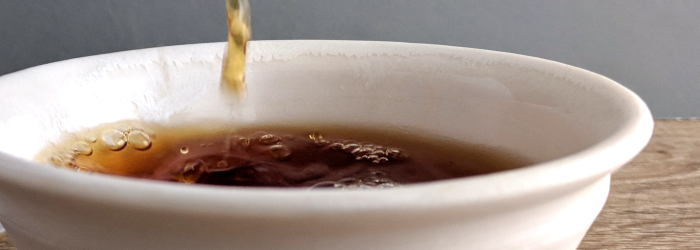Types of Black Tea: Indian vs. Chinese Traditions

Within the broadly defined category of fully oxidized teas, there are an infinite number of variations. Black teas can vary in flavor based on the specific environmental features of local terroir, the weather and maturity of the plant when it is harvested, and the way in which the leaves are picked and crafted. But the unique history of the tea trade has also shaped the landscape of fully oxidized styles into two distinct families: those from China, and those from India.
Because the Indian tea industry was shaped by the forces of British imperialism, in a climate wholly different from historically insular China, the teas that developed there are distinct in many ways. From the basic variety of Camellia sinensis used to the way the leaves are grown, harvested and crafted. Of course, vast range exists within the teas produced in each country as well, but today we’ll cover some of the general qualities that make these two styles so different from one another.
Variety
Above all, the most basic distinction between Chinese and Indian teas boils down to a natural subdivision in the Camellia sinensis species, between Camellia sinensis sinensis from the temperate climates of China, and Camellia sinensis assamica, native to the tropical climate of India. Evolution has molded the characteristics of these subspecies to flourish in their respective habitats. The difference is easiest to see in the overall size of the leaves: assamica leaves are generally larger, and better suited to soaking up extra sun.
This easy distinction has a few exceptions, however. Early British innovators did not immediately recognize that these two plants belonged to the same species, and invested many years in a bid to smuggle plants from the secretive Chinese industry before discovering the assamica subspecies right under their noses. Despite the inherent difficulty, their stolen plants flourished in the highlands of Darjeeling. Later, in the 20th century, the Japanese transplanted Assam plants to Taiwan, as well, creating the foundation for the range of hybrid ‘Formosa Red’ varieties that exists today.
Terroir
No matter the subspecies or variety, the specific terroir of each tea garden will impact the flavor of the finished tea. Some aspects of terroir, like elevation, have similar effects in each country, but the overall difference between the temperate climate of China and the tropical climate of India makes for the clearest divide in flavor. No matter what other variables are at play, lower average temperatures and limited sunlight cause the tea plant to grow more slowly, thus developing more complex flavors and less bitterness.
On the other hand, fast growth powered by annual monsoons and increased light exposure made Indian crops ideal for the purposes of European export. Production costs could be efficiently lowered with higher yields, and plentiful dairy products in Europe made bitterness easy to overcome. Plus the bold, straightforward flavors of Indian teas could withstand a sea journey without going stale, and were familiar to drinkers transitioning from teas grown for export in the hot, wet lowlands of China.
Craftsmanship
Ultimately, the biggest difference between Chinese and Indian styles of tea stems from the unique history of each country. Developed under British colonial rule, the Indian plantation system bears a close resemblance to other historical western agriculture, with workers serving a small class of landowning elites that profit from maximum production. Because the majority of the British and European market was working class, innovators pushed to find solutions that would increase yields and consistency, rather than experimenting to discover complex flavors.
In China, because everyday teas are grown all over, profits stemmed from impressing the elite, who took tea incredibly seriously. Even today, the tea culture is shaped by a long history of imperial decrees, and famous styles are inevitably descended of imperial favorites. On top of the overall demand for quality, the repercussions of the Cultural Revolution left tea farms on relatively equal footing after land was redistributed to those with ancestral claims. Because no single farmer had enough land to produce a dominant quantity, exercises like tea competitions became popular to determine those deserving of the highest prices.
Of course, in today’s diverse market, many Chinese teas are produced on large, consolidated farms, and many artisanal teas are grown and carefully hand-crafted in India. Teas from both countries can be grown slowly at high elevations, or rapidly with the help of fertilizers in the lowlands. But understanding this contextual difference between the traditions of each region can make the wide world of tea a little easier to navigate.
Do you prefer Chinese or Indian black teas? Let us know in the comments below!






Comments on this post (1)
i appreciate your blog posts. I like to understand what I eat or drink! I came here while doing a quick web search on the steps of tea leaf processing and learned a lot on your site. I do not have a favorite between the two regions, just favorites of varieties/types. I have not found a green that I just love, but I have found several blacks, over the last 10 years, that I keep going back to. One is a very “normal” Assam British Breakfast style that is consistent – very reddish and a pretty balanced flavor if one is very careful about temperature of the water, otherwise the tannin bite soars. Otherwise I prefer a couple of “golden Yunnan” types I’ve found, and rejected a bunch of others in that gold zone. White teas I’m working on. One favorite that is very expensive, and one more modest, among a number of “meh” white teas. Oolongs I need help. Pu-ehr that I have tried [about a half dozen] all consistently give me gastric trouble and I have no idea why. I’m guessing they are pro=biotic and unbalance the system
— Richard Brown